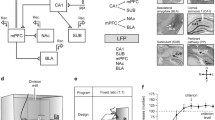Abstract
Four rats were first trained to make a light-dark discrimination by making electrical stimulation of the brain (ESB) available to them for responses made in the presence of one stimulus (S D), but not in the presence of another stimulus (S Δ). Subjects were then tested following treatment with pilocarpine, scopolamine, and combinations of the two. Pilocarpine (2.5 and 5.0 mg/kg) significantly reduced the rate of reinforced responding, in the presence of S D, but did not affect the rate of unreinforced responding, in the presence of S D. On the other hand, scopolamine (2.5 mg/kg) did not affect response rates during S D, but did significantly enhance responding during S D. Furthermore, when given in combination, the two drugs failed to antagonize eath other's actions. Instead, the outcome was equivalent to the sum of the two separate effects: i.e., decreased responding during S D and increased responding during S Δ.
These results support the conclusions that 1. a pilocarpine-sensitive, inhibitory neural subsystem opposes response activation produced by ESB, in the presence of a discriminative stimulus (S D), and 2. a separate muscarinic inhibitory system which is not sensitive to pilocarpine opposes the activation of non-reinforced responses, i.e., in the presence of S Δ.
Similar content being viewed by others
References
Boren, J. J., Navarro, A. P.: The action of atropine, benactyzine and scopolamine upon fixed-interval and fixed-ratio behavior. J. exp. Anal. Behav. 2, 107–115 (1959)
Carlton, P. L.: Cholinergic mechanisms in the control of behavior by the brain. Psychol. Rev. 70, 19–39 (1963)
DeGroot, J.: The rat forebrain in stereotaxic coordinates. Amsterdam: N. V. Noord Hollandsche Uitgevers Maatschappij 1963
Domino, E. F., Olds, M. E.: Cholinergic inhibition of selfstimulation behavior. J. Pharmacol. exp. Ther. 164, 202–211 (1968)
Domino, E. F., Olds, M. E.: Effects of d-amphetamine, scopolamine, chlordiazepoxide and diphenylhydantoin on self-stimulation behavior and brain acetylcholine. Psychopharmacologia (Berl.) 23, 1–16 (1972)
Fibiger, H. C., Lynch, G. S., Cooper, H. P.: A biphasic action of central cholinergic stimulation on behavioral arousal in the rat. Psychopharmacologia (Berl.) 20, 366–382 (1971)
Fibiger, H. C., Lytle, L. D., Campbell, B. A.: Cholinergic modulation of adrenergic arousal in the developing rat. J. comp. physiol. Psychol. 72, 384–389 (1970)
Goldberg, M. E., Johnson, H. E., Knaak, J. B.: Inhibition of discrete avoidance behavior by three anticholinesterase agents. Psychopharmacologia (Berl.) 7, 72–76 (1965)
Goodman, L. S., Gilman, A.: The pharmacological basis of therapeutics. New York: Macmillan 1965
Hearst, E.: Effects of scopolamine on discriminated responding in the rat. J. Pharmacol. exp. Ther. 126, 349–358 (1959)
Hernnstein, R. J.: Effects of scopolamine on a multiple schedule. J. exp. Anal. Behav. 1, 351–358 (1958)
Hull, C. L.: Principles of behavior. New York: Appleton-Century-Crofts 1943
Johnson, D. B., Anderson, C., Khalili, J., Beatty, W. W.: Effects of atropine on performance of an S D-S Δ discrimination in rats. Psychon. Sci. 26, 23–24 (1972)
Jung, O. H., Boyd, E. S.: Effects of cholinergic drugs on self-stimulation response rates in rats. Amer. J. Physiol. 210, 432–434 (1966)
Meliska, C. J., Carlson, N. J.: Effects of scopolamine and eserine on extinction of runway responding. Paper read at Midwest Psychological Association Convention, Cincinnati, Ohio, May 1970
Newman, L. M.: Effects of cholinergic agonists and antagonists on self-stimulation behavior in the rat. J. comp. physiol. Psychol. 79, 394–413 (1972)
Olds, M. E.: Comparative effects of amphetamine, scopolamine, chlordiazepoxide and diphenylhydantoin on operant and extinguished behavior with brain stimulation and food reward. Int. J. Neuropharmacol. 9, 519–532 (1970)
Olds, M. E.: Alteration by centrally acting drugs of the suppression of self-stimulation behavior in the rat by tetrabenazine, physostigmine, chlorpromazine and pentabarbital. Psychopharmacologia (Berl.) 25, 299–314 (1972)
Olds, M. E., Domino, E. F.: Comparison of muscarinic and nicotinic cholinergic agonists on self-stimulation behavior. J. Pharmacol. exp. Ther. 166, 189–204 (1969)
Pfeiffer, C. C., Jenney, E. H.: The inhibition of the conditioned response and the counteraction of schizophrenia by muscarinic stimulation of the brain. Ann. N. Y. Acad. Sci. 66, 753–764 (1957)
Sawicky, T. E., Meliska, C. J.: The development of a free operant light-dark discrimination using intracranial reinforcement. Physiol. Psychol. 1, 97–100 (1973)
Stark, P., Boyd, E. S.: Effects of cholinergic drugs on hypothalamic self-stimulation response rates in dogs. Amer. J. Physiol. 205, 745–748 (1963)
Stark, P., Totty, C. W., Turk, J. A., Henderson, J. K.: A possible role of a cholinergic system affecting hypothalamic-elicited eating. Amer. J. Physiol. 214, 463–468 (1968)
Vaillant, G. E.: A comparison of antagonists of physostigmine-induced suppression of behavior. J. Pharmacol. exp. Ther. 157, 636–648 (1967)
Zetler, G.: Cataleptic state and hypothermia in mice, caused by central cholinergic stimulation and antagonized by anticholinergic and antidepressant drugs. Int. J. Neuropharmacol. 7, 325–335 (1968)
Author information
Authors and Affiliations
Additional information
This work was supported in part Grant No. 11015 from the Psychopharmacology Division, American Psychological Association.
Rights and permissions
About this article
Cite this article
Meliska, C.J., Sawicky, T.E. Differential effects of pilocarpine and scopolamine on the performance of a light-dark discrimination maintained by electrical stimulation of the brain. Psychopharmacologia 36, 29–39 (1974). https://doi.org/10.1007/BF00441379
Received:
Revised:
Issue Date:
DOI: https://doi.org/10.1007/BF00441379




